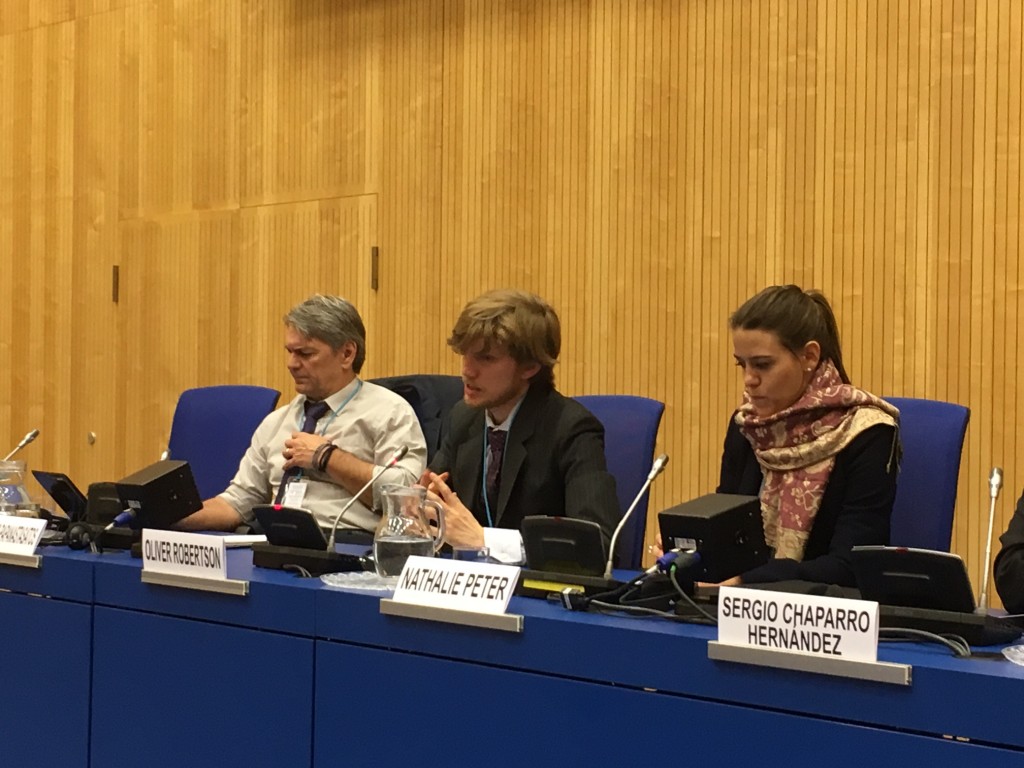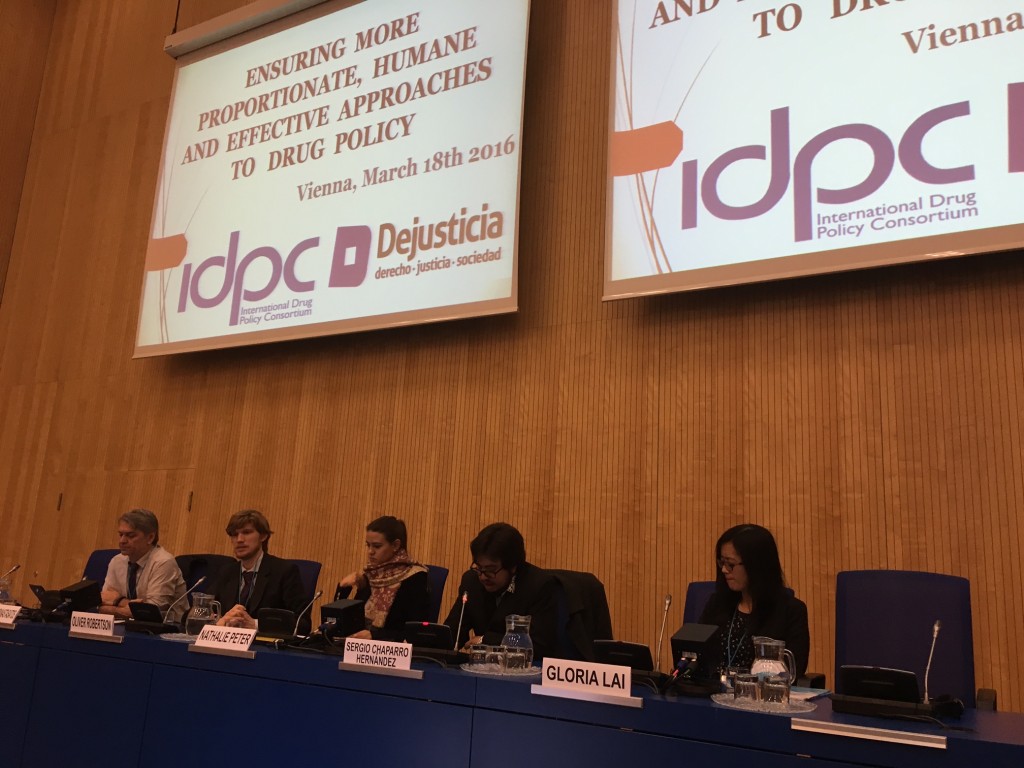Nathalie Peter, Uruguay. Today, we focus on the importance of ensuring more humane and proportionate drug policies. Prison overcrowding and human rights violations have been a direct result of disproportionate penalties. In this event we provide an overview of the concept of proportionality, offer best practice examples and recommendations for reform.
Gloria Lai, IDPC. I will speak briefly about proportionality as explained in the IDPC drug policy guide. We also released this week principles of practices of decriminalisation in Asia, with a view of how implementation of decriminalisation could work in Asia. Other panellists will talk about the disproportionate nature of sentencing, so I will look at the impacts of disproportionate sentencing, and what a more proportionate framework would look like.
After decades of excessively severe sentences, there has not been deterrence in people’s involvement in the illicit drug market. Activities related to supply have not declined. Even despite policies imposing harsh punishment, these have failed to reduce supply and demand. But these have also resulted in severe impacts on public health, for example for people who use drugs. Prisons have become high risk settings for the transmission of HIV, TB, hep C. In terms of human security, severe punishments including the death penalty have not impacted upon the scale of the illicit market as it targets the poorest and most marginalised who are easily replaced in the market. People engaging in high level crime continue unhindered. This is therefore resulting in an unbalanced investment of resources on minor drug offenders instead of targeting high level criminals. Lastly, incarcerating people involved in illicit crop production for subsistence purposes and other low level actors exacerbates poverty and inequality.
Defining proportionality: internationally recognised legal principle requiring that punishment be measured in accordance with the harms caused by an offender’s actions and the culpability and circumstances of the offender. The 3 drug conventions don’t require states to impose criminal sanctions for drug use. They also don’t contain specific provisions about criminalising other activities related to drug use. The conventions suggest some guidance for ensuring proportionality by differentiating consumption/sale and between low level and high level offences. There are also schedules to classify substances.
How to implement more proportionate sentencing around the world: in the IDPC Guide we include examples of how this has been implemented in the UK, Costa Rica and Ecuador. Proportionality is important for drug offences, but also in accordance with other crimes, such as murder and rape.
A distinction between different roles and motivation is key to proportionality. We also need to implement both aggravating AND mitigating factors – the latter are usually not used. For example, women are in a particularly vulnerable situation as caregivers and this should be recognised in sentencing practices.
A final key recommendation is that sentencing is proportionate as a principle but the framework should also ensure better outcomes in terms of heath, human security and development.
Oliver Robertson, Penal Reform International. I work for PRI, which is very focused on prison issues. Among the various effects discussed on health, well being and appropriate sentencing, the biggest effect we have seen from drug policies is the impact on overcrowding of prisons due to long sentencing, pre-trial detention. Some people can be held in pre trial detention for months or years in some countries. Prison overcrowding affects everything else in prison: difficult to manage prisons, staff can’t spend as much time with prisoners to support their rehabilitation and address individual issues, prisoners themselves can’t undergo education or training due to lack of staff or no funding. Prisoners can then become more frustrated, you have no privacy or space. This feeds back into other problems and exacerbates them. Nearly 60% of prisons are over 50% overcapacity.
In terms of reversing this trend, it is going to involve having fewer people in prison as the alternatives are going to be expensive by building more prisons, or you need to increase prison capacity leading to more prison overcrowding. This also involves getting people out sooner.
PRI calls for people to only go to prison if they are a danger to society. It may be harder to convict the kingpin, but that’s where NGOs have a role in ensuring that governments don’t go for the easy option of targeting users or cutting corners in due process in trial. Other ways to change the situation include:
- changing what success looks like in terms of metrics, stopping to focus on numbers incarcerated, but instead the proportion of people incarcerated for minor drug offences – the lower, the better.
- if you want to have fewer arrests for drug offences, then make it bureaucratic for the police to arrest them so that it’s difficult for them to arrest low level offenders.
- proportionate sentencing means lots of different elements – sentencing guidelines in some countries provide mitigating factors, for example: level of harm caused, proportionality vis a vis other offences, individual circumstances (e.g. caregiver, breaking the taboo on “being a bad person, bad parent, therefore needing to be punished).
- alternatives could be non-custodial sentencing, could be deportation for drug couriers, could be diversion into treatment, could be diversion to support services, could be doing nothing (limited, negligible harm).
Sergio Chaparro, Dejusticia. In Latin America, trafficking of cocaine is more serious than murder or rape. This is the result of a study from CEDD. For this and other reasons, it is not an exaggeration to conclude that the Americas have an addiction to conviction. This is counter-productive. Let’s take a look at the evolution of the number of drug related conducts being criminalised since legislation was passed on drugs. The numbers of articles in legislation increased from fewer than 10 in the 1950s to more than 100 today describing criminal offences related to a range of involvements in the drug trade.
In addition, penalties have also increased for these drug-related conducts. In over 60 years, the aggregate max penalties have increased by 450%. This addiction to punishment has led to extremely high penalties for drug offences. The max penalty for drug trafficking is greater than murder in Colombia, Mexico and Ecuador, and is equal or greater than for rape.
Minor drug offences are being prosecuted more than for high level crimes. State prosecution for minor drug offences is much higher than for money laundering. This shows that law enforcement is selective, tough on the weak and weak on the tough. This is focused on vulnerable groups – race, women.
I now turn to the gender distribution in the justice system – only 9% of police catches involve women, conviction of women is 20% of all conviction. I invite you to read the Guide by WOLA, IDPC, DeJusticia and CIM on this issue.
There are documented cases where drug lords funded military groups to arrest minor drug offences. Some women were condemned to 5-6 years in prison. Disproportionate sentencing is not only unjust, it also has some serious impacts. Convictions for drug crimes have increased at a faster rate than the overall prison population. This is the case, for example, in Brazil – where those sent to prison are low level actors that are easily replaced. Millions of non-violent offenders are being sent to prison, more than those sent to prison for higher level crimes. The state has the responsibility to ensure just and fair trials.
Reducing sentencing should not be seen as being soft on crime. It is about responsibility and compassion.
Gerasimos Papanastasatos, Kethea, Greece. I have an identification crisis here. I am a political representative, but I also have a professional role. I am a university teacher on criminal law. Proportionality is not easy. It appears as so self evident. Proportionality is the concept by which punishment should be proportionate to the severity of the crime itself. In physics, it is the concept by which the whole design is understood. Previous speakers said that metrics are important when we evaluate success. You must measure the size of one object with another, then compare the sizes of the two objects. This is a metaphor but it is what we need to apply this in the criminal justice system. The sentence must be right in terms of balancing the harm of the crime towards the victim and the crime committed. This is needed to legitimate the justice power as a neutral and independent institution – it is the cornerstone of the social contract. It is a prominent legal principle. Different forms of balancing the content of rules and their application recognises international jurisprudence which state that the sentence must be necessary, that there is no other way to achieve the objective, and that the consequences on the aggrieved party’s rights are reasonable. The principle of proportionality constitutes a limitation of restrictions, of constitutionally guaranteed rights. It is the reasonable relationship between the restrictive measure and the aim. Between the two there must be a reasonable ratio.
Three principles are present when we apply proportionality – suitability (appropriate restriction, measure should be suitable to achieve the aim), necessity (the restriction must be necessary), proportionality (the weight of the cost-benefit).
We must compare the harshness of the penalty within the criminal justice system within and among other jurisdictions. The concept of proportionality is a new one. It is from the 17th century. Proportionality is a provocative concept for many of the participants at CND, probably because as a legal principle does not pose questions, it gives answers, in the framework of democracy and social security.
Questions and answers:
LEAP. We support all the work you’re doing. But I want to express a cautionary note – I came across a woman whose son was incarcerated for 20 years for cannabis. She said it would be best to serve 2 years. I told her that zero would be best! We need to stop being satisfied with a kinder, gentler drug prohibition. We should work ultimately to end prohibition that creates all this suffering and death.
Question. When we start talking about proportionality, we often forget the individual circumstances. Can the panel share their experience on how to apply this?
Oliver. It is important to be aware of the difference between sentencing grids and guidelines. Grids are much more prescriptive. Guidelines are best as they are more flexible. They often tell you about the factors you should consider, but allow flexibility to deviate from that if it is a special case. I’d encourage a grid system to move away from being so prescriptive.
IDPC. Can you describe how to apply the principle of proportionality for women?
Sergio. We designed a guide on women to reduce incarceration. For example: eliminate minimum mandatory sentences for drug offences, consider different kinds of mitigating factors – participation in criminal groups, caregiver, etc. We also call for decriminalisation. The high cost of criminalisation means that the drug problem must be addressed differently with a new focus.
Nathalie. Allow me to sum up by saying that a health and human rights based drug policy means that states should stop criminalising people who use drugs. This approach would help us focus on more harmful aspects such as organised crime. Uruguay works actively to promote decriminalisation and proportionate sentencing. We must stop thinking about ideology, but move towards evidence and placing the human being at the centre of our policies.


